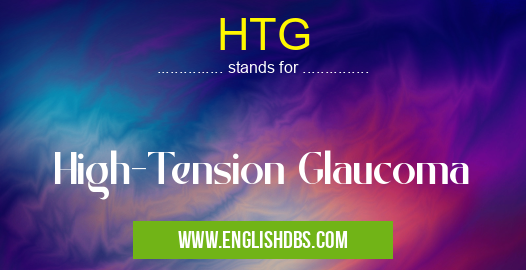What does HTG mean in OPTOMETRY
HTG, short for High-Tension Glaucoma, is a severe eye condition characterized by abnormally high pressure within the eyes. This pressure damages the optic nerve, potentially leading to permanent vision loss. Understanding HTG is crucial for early detection and effective management.

HTG meaning in Optometry in Medical
HTG mostly used in an acronym Optometry in Category Medical that means High-Tension Glaucoma
Shorthand: HTG,
Full Form: High-Tension Glaucoma
For more information of "High-Tension Glaucoma", see the section below.
What is HTG?
HTG, also known as chronic open-angle glaucoma, occurs when the fluid inside the eyes (aqueous humor) cannot drain properly through the drainage channels. This blockage leads to increased pressure within the eyes, damaging the delicate optic nerve that transmits visual information to the brain.
Causes of HTG
The exact cause of HTG is often unknown, but it is believed to be associated with factors such as:
- Increased production of aqueous humor
- Impaired drainage of aqueous humor through the drainage channels
- Family history of glaucoma
- Advanced age
- Certain medications (e.g., steroids)
- Eye injuries or surgeries
Symptoms of HTG
Early stages of HTG often have no noticeable symptoms. As the condition progresses, patients may experience:
- Blurred vision
- Tunnel vision
- Pain in the eyes
- Headaches
Diagnosis of HTG
HTG is diagnosed through a comprehensive eye exam that includes:
- Measuring intraocular pressure (IOP)
- Dilating the pupils to examine the optic nerve
- Checking the drainage angles
Treatment of HTG
The goal of HTG treatment is to reduce intraocular pressure and prevent further damage to the optic nerve. Treatment options may include:
- Eye drops that reduce the production of aqueous humor or improve drainage
- Laser therapy to open blocked drainage channels
- Surgery to create a new pathway for fluid drainage
Essential Questions and Answers on High-Tension Glaucoma in "MEDICAL»OPTOMETRY"
What is High-Tension Glaucoma (HTG)?
HTG is a type of glaucoma in which intraocular pressure (IOP) is consistently elevated, typically above 21 mm Hg. Elevated IOP can damage the optic nerve, leading to vision loss.
What are the risk factors for HTG?
Risk factors include:
- Age over 60
- Family history of glaucoma
- High refractive error (nearsightedness or farsightedness)
- Certain medical conditions, such as diabetes or high blood pressure
What are the symptoms of HTG?
In most cases, HTG has no noticeable symptoms in its early stages. As the disease progresses, symptoms may include:
- Blurred vision
- Seeing halos around lights
- Eye pain
- Redness
How is HTG diagnosed?
Diagnosis involves a comprehensive eye exam, including a visual field test, optic nerve evaluation, and IOP measurement. Your eye doctor may also recommend imaging tests, such as an OCT scan, to assess the health of your optic nerve.
How is HTG treated?
Treatment focuses on lowering IOP to prevent further optic nerve damage. Options include:
- Eye drops
- Laser therapy
- Surgery
What are the goals of HTG treatment?
The primary goal is to preserve vision by reducing IOP to a level that is safe for your optic nerve health. Treatment aims to prevent further vision loss and maintain your current level of vision as much as possible.
What is the prognosis for HTG?
The prognosis depends on the severity of the disease and how well it responds to treatment. Early detection and aggressive management can significantly improve the chances of maintaining good vision.
Final Words: HTG is a serious eye condition that requires prompt diagnosis and treatment. By understanding the causes, symptoms, and treatment options of HTG, individuals can take proactive steps to preserve their vision and maintain eye health. Regular eye exams are crucial for early detection and timely intervention to prevent irreversible vision loss.
